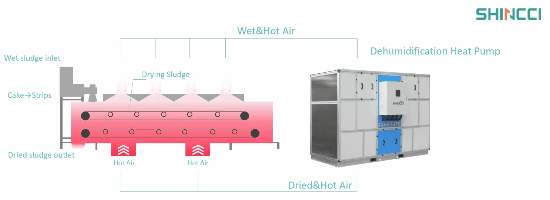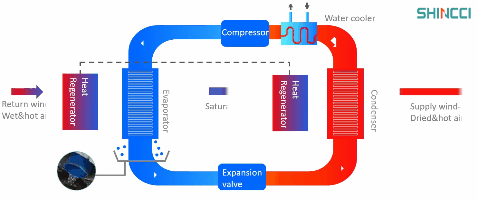 Drying Technology
Drying Technology
According to the statistics of the Ministry of Environmental Protection, in 2014, the total design and processing capacity of urban sewage treatment facilities in the country was 171 million m³/day, and the average daily treated water volume was 135 million m³. Sludge production is related to the level of sewage treatment technology and standards, accounting for 0.3% to 0.5% of the treated water (97% water content), and about 1t dry sludge per 10,000 m³ of sewage, 2014 national The amount of sludge produced per day has reached 13,500 tons of dry sludge, which is equivalent to about 67,500 tons of sludge with a moisture content of 80%.
Sludge is a floc composed of water, organic particles and inorganic particles. It contains a lot of heavy metals, pathogens and toxic organic substances that are difficult to degrade. It also emits odor. If the sludge is not treated effectively, it will seriously pollute the environment. It has affected people's health, sludge disposal and resource utilization have become the focus of environmental protection.
At present, sludge pretreatment has technologies such as conditioning, concentration, dehydration, stabilization and drying. The final disposal of sludge includes landfill, land use, building materials utilization, biological treatment and incineration, pyrolysis, gasification and emerging technologies such as thermal hydrolysis are also being researched and developed.
Sludge incineration is a common sludge disposal method. The organic matter in the sludge is completely converted into CO2 and H2O products after combustion reaction with sufficient oxygen under high temperature conditions, thereby realizing sludge volume reduction and harmless. To achieve good results, the "3T" principle should be met, that is, to ensure proper incineration temperature, flammable and oxygen mixed thoroughly and the residence time required for the reaction to complete.
After the sludge is concentrated and mechanically dehydrated, there is still a high water content. In order to reduce the moisture content of the sludge entering the boiler and increase the calorific value of the sludge, the sludge needs to be dried. By drying, the moisture in the dewatered sludge can be further evaporated to avoid or reduce the auxiliary fuel consumption and reduce the heat loss of the boiler exhaust. Therefore, the treatment and disposal technology combined with incineration can maximize the reduction and resource utilization of sludge, and has a good application prospect.
Sludge drying technology
The removal of water in sludge drying mainly undergoes evaporation and diffusion processes, including traditional thermal drying, solar drying, microwave heating drying, ultrasonic drying and biological drying. At present, the most widely used is the thermal drying technology. The sludge thermal drying technology can be divided into direct thermal drying, indirect thermal drying and direct-indirect combined thermal drying technology according to the contact mode of the heat medium and the sludge.
Direct thermal drying technology
Direct thermal drying is the use of hot smoke or hot air and other media, direct contact with the sludge, the water in the sludge is evaporated under high temperature, the sludge solid content is increased to 85%, the technology can be operated in an oxygen-free or low-oxygen environment. After drying, the sludge is granular, the particle size can be controlled, the dry exhaust gas is recycled, the exhaust gas is reduced, and the total treatment cost is reduced. Related drying equipment includes spray drying towers, belt dryers, drum dryers, cyclone flash sludge dryers, and the like.Taking spray drying as an example, the working principle is to use an atomizer to disperse the sludge into droplets and dry it with hot air. Since the sludge is easily combusted under high temperature conditions, the downstream flow is often used for co-current drying, that is, the nozzle is installed at the top of the tower, and the sludge and hot air are all entered from the top of the tower, and are contacted and mixed in the highest temperature region, in the sludge. The moisture quickly evaporates, causing the air temperature to drop sharply; when the particles move to the lower part of the tower, the drying is completed and the air temperature is also lowered to the lowest point.The advantage of this technology is that the sludge and the heat medium are in direct contact, the transmission efficiency and evaporation rate are high, the drying process is short, the equipment structure is compact, and the initial investment is low; the disadvantage is that high temperature flue gas or hot air is used as the heating heat source, and the available energy loss is large. The flow rate of dry exhaust gas is large, exhaust gas purification and waste heat recovery are difficult; the anti-combustion and explosion-proof requirements of the drying system are more demanding.

Indirect thermal drying technology
Indirect thermal drying is the transfer of heat from the steam or heat transfer oil provided by the heating device to the sludge on the other side through the surface of the heat transfer element of the drying device to evaporate the water in the sludge. The water evaporated by the sludge enters the condenser for condensation, and the heat medium is returned to the original system in whole or in part for recycling. The main equipments include hollow paddle dryer, indirect contact rotary dryer, rotary dryer, and thin layer dryer.In the commonly used paddle type dryer, the main heat transfer surface is the surface of the hot blade of the hollow blade welded on the two hollow shafts, and the blade is wedge-shaped, which has the function of stirring and squeezing the sludge. Since the two intermeshing hot shafts rotate in opposite directions, the sludge can be cleaned to prevent sticking walls and affect the heat transfer effect. The paddle type drying machine has large heat transfer surface, compact structure and small floor space; no air circulation is required, the internal oxygen content is low, and the device is safe and reliable; it can adjust the amount of sludge, sludge transportation speed, heat supply, etc. To prevent the fluctuation of moisture content in the sludge, but there is no axial thrust in itself, the material is difficult to mechanically empty, and the heat exchange surface does not have mechanical forced renewal, which is easy to scale. Indirect thermal drying technology uses low-grade steam and other low-grade heat sources, with low energy loss and high system thermal efficiency; dry exhaust gas treatment is small, and dry steam is easy to condense; it can effectively avoid the forming phase of sludge, and the operating temperature is low. The loss of combustible components in the sludge is small; the system is safe and the degree of automation is high. However, sludge and heat medium belong to the partition wall heat transfer, the heat transfer coefficient is lower than the direct contact heat transfer, the drying rate is low, the unit drying area is small, the equipment volume is large, the initial investment is high, and the drying equipment is transmitted. The thermal element has a complicated structure, many moving parts, and high requirements for corrosion resistance and wear resistance.
